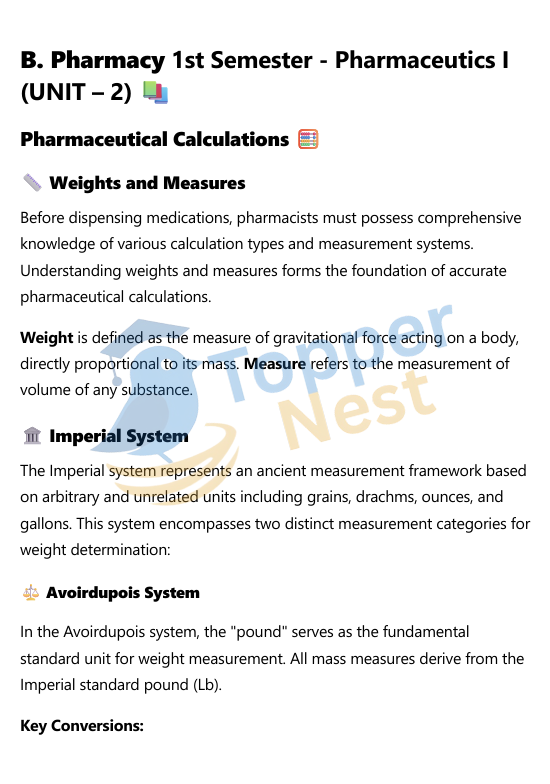Understanding the fundamentals of pharmaceutical calculations, powder formulations, and liquid dosage forms is crucial for every pharmacy student. These topics are not just theoretical—they have direct applications in dispensing, compounding, and drug formulation in both clinical and industrial pharmacy settings.

What is Pharmaceutical Calculations?
Pharmaceutical calculations are a critical set of mathematical procedures used in pharmacy to ensure the safe and accurate preparation, dispensing, and administration of medications. They are essential for every pharmacist, technician, and healthcare professional to prevent medication errors, which can have serious consequences for patients.
Pharmaceutical calculations are a critical set of mathematical procedures used in pharmacy to ensure the safe and accurate preparation, dispensing, and administration of medications. They are essential for every pharmacist, technician, and healthcare professional to prevent medication errors, which can have serious consequences for patients.
Key Areas of Pharmaceutical Calculations
Pharmacists perform various types of calculations daily, including:
- Dose Calculations: Determining the correct amount of drug to be given to a patient based on factors like their weight, age, or body surface area (BSA).
- Concentration and Dilution: Preparing solutions of a specific strength from a more concentrated stock solution. This often involves the use of the C1V1 = C2V2 formula, where C is concentration and V is volume.
- Powder Calculations: Determining the amount of a drug substance needed to prepare a specific quantity of a dosage form (like capsules or tablets) or a liquid preparation.
- Alligation: A method used to mix two or more solutions of different strengths to achieve a desired intermediate strength. This is particularly useful for preparing topical creams or ointments.
Powders
Powders are solid dosage forms consisting of a mixture of finely divided drug and excipient particles. They can be used for both internal (oral) and external (topical) applications. Powders are one of the oldest forms of medication and remain a versatile and common choice for drug delivery.
Advantages and Disadvantages of Powders
| Advantages | Disadvantages |
| Rapid Onset: Drugs in powder form dissolve and are absorbed quickly. | Taste: Unpleasant-tasting drugs are difficult to mask. |
| Stability: More chemically stable than liquids. | Handling: Can be messy and difficult to handle. |
| Flexible Dosing: Doses can be easily adjusted for individual patients. | Uniformity: In bulk powders, dose accuracy relies on the patient’s measurement. |
| Ease of Swallowing: Can be mixed with food or liquids, making them suitable for children and the elderly. | Inhalation Risk: Fine powders can be accidentally inhaled during administration. |
Liquid dosage forms
Liquid dosage forms are pharmaceutical preparations in which the active drug substance is dissolved or suspended in a liquid vehicle. They are a versatile class of medications, offering several advantages and a wide variety of formulations for different routes of administration.
Key Characteristics of Liquid Dosage Forms
- Ease of Swallowing: Liquid forms are particularly suitable for patients who have difficulty swallowing solid dosage forms like tablets and capsules, such as children, the elderly, and those with certain medical conditions.
- Rapid Absorption: Drugs in a liquid form are often absorbed more quickly by the body than solids, as they do not need to disintegrate and dissolve before absorption. This leads to a faster onset of action.
- Flexible Dosing: Dosing can be easily adjusted to a specific patient’s needs by simply changing the volume of liquid, which is especially useful in pediatrics and for potent medications.
- Homogeneity: A properly formulated liquid preparation ensures that each dose contains a uniform amount of the active ingredient, preventing dose variability.
- Stability: Some drugs are more stable in a liquid form, but many are less stable due to the presence of water, which can promote hydrolysis and microbial growth. This often necessitates the inclusion of preservatives and antioxidants.
Advantages and Disadvantages of Liquid Dosage Forms
| Advantages | Disadvantages |
| Easy to swallow. | Shorter shelf life and lower chemical stability (especially water-based). |
| Rapid onset of action. | Potential for microbial growth. |
| Flexible dosing. | Inaccurate dosing if not measured carefully by the patient. |
| Mask unpleasant tastes and odors. | Bulkier and heavier to transport than solid forms. |
| Good for patients who need immediate relief. | Not suitable for drugs with a very bad taste. |
FAQs – Pharmaceutics Unit 2
1. Why is geometric dilution important in powder mixing?
It ensures even distribution of potent drugs, preventing dose variability and therapeutic failure.
2. What are hygroscopic and efflorescent powders?
- Hygroscopic powders absorb moisture from the air.
- Efflorescent powders lose water when exposed to air.
3. What are proof spirits used for in pharmacy?
They represent the alcohol concentration in preparations and are used in formulating tinctures and extracts.
4. Which methods are used to prepare isotonic solutions?
- Freezing point depression method
- Sodium chloride equivalent method
These ensure the solution is safe for injection or ophthalmic use.
5. What is the role of solubility enhancers in liquid dosage forms?
They improve the bioavailability of poorly soluble drugs by increasing their solubility and dissolution rate.
